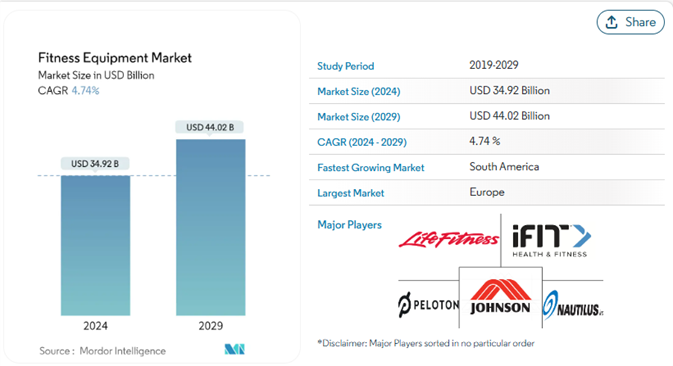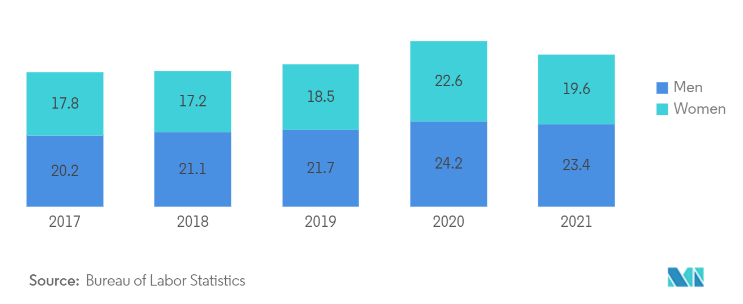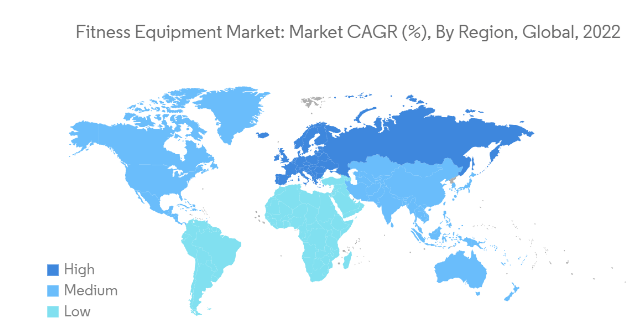Overreview of the share market of the fitness equipment
The Global Fitness Equipment Market Report is Segmented by Product Type (Treadmills, Elliptical Machines, Stationary Machines, Rowing Machines, Strength Training Equipment, and Other Product Types), Category (Residential and Commercial), Distribution Channel (Offline Retail Stores and Online Retail Stores), and Geography (North America, Europe, Asia-Pacific, South America, and Middle East and Africa). The Report Offers Market Size and Values (in USD) During the Forecasted Years for the Above Segments.

Fitness Equipment Market Analysis
The Fitness Equipment Market size is estimated at USD 34.92 billion in 2024, and is expected to reach USD 44.02 billion by 2029, growing at a CAGR of 4.74% during the forecast period (2024-2029).
Diabetes, obesity, high blood pressure, and arthritis are somecommon chronic diseases that are prevailing in the world due to lifestylechanges, changes in food habits, and overconsumption of high-caloriefoods. Due to the prevalence of these diseases, people have become moreconscious of their health and fitness. Premature weakness in bones andmuscles is a problem in the young generation due to the frequentconsumption of fast food and alcoholic beverages.
Because of their awareness of such issues, going to fitnesscenters and working out has become a trend. The growing preference for ahealthy and fit lifestyle drives the fitness equipment market growth.There is also a surge in fitness centers and health clubs worldwide,further propelling the market growth.
Growing government initiatives related to health awareness arealso propelling market growth. These initiatives aim to promote andprotect health by guiding at the individual, national, and global levelsin reducing disease and death rates related to unhealthy diets andphysical inactivity, boosting consumers’ interest in fitness activities.
Due to advanced technology, market players are venturing onpartnerships to launch new products with advance technologies. Forinstance, in April 2021, Matrix, a Johnson Health Tech Co. brand,partnered with iFIT, a global leader in interactive connected fitnesstechnology and content. This partnership aims to incorporate iFit'sdigital technology into Matrix's products.
Fitness Equipment Market Trends, Inclination Toward a Healthy Lifestyle
The rising prevalence of lifestyle diseases, such as diabetes,obesity, hypertension, and high blood pressure, due to unhealthy dietarypatterns and physical inactivity encourages the participation ofindividuals in fitness regimes. According to StatCan, in 2021, around 29%of adults in Canada aged 18 years and older were obese, while 36% wereoverweight. Thus, people are inclined toward a healthy lifestyle, drivingthe fitness equipment market.
Besides this, government initiatives to promote participationin physical activities and strengthen links between the community andvarious sports and fitness organizations are propelling the market growth.Moreover, market players are introducing connected fitness equipment.
For instance, in September 2022, Nautilus Inc. launched theBowflex BXT8J treadmill with the JRNY adaptive fitness app. The treadmillcan pair with a mobile device or tablet to provide access to the fitnessapp.

Europe is the Largest Market for Fitness Equipment
Fitness equipment in the United Kingdom reflects a diverse andgrowing market driven by a heightened awareness of health and wellness.Traditional gym equipment like treadmills, stationary bikes, andweightlifting machines remains popular. Still, home fitness equipment hasa rising trend, including smart exercise machines, connected fitness apps,and compact workout gear.
With a well-established gym culture and a focus on physicalfitness, Germany has a wide array of fitness facilities and a strongdemand for professional training services. For instance, in 2022,according to EuropeActive, the European Health and Fitness Association(EHFA), the number of fitness club members in Germany was 10.3 million.
Increased awareness of the benefits of regular exercise foroverall health and well-being has encouraged individuals to prioritizephysical activity in Spain. For instance, according to a survey by theMinistry of Education, Culture and Sport, nearly 27% of men and 20.7% ofwomen exercised daily in Spain in 2022.
Governments in different countries of Europe promote healthylifestyles through public health initiatives and campaigns. This includesencouraging physical fitness and exercise to combat obesity and relatedhealth issues. As a result, there is an increasing awareness of theimportance of fitness, which drives the demand for fitness equipment incommercial fitness facilities and for personal use.



 Tel : +0592 6105769
Tel : +0592 6105769 Fax : +0592 6105769
Fax : +0592 6105769 Email : sales@wuwind.com
Email : sales@wuwind.com